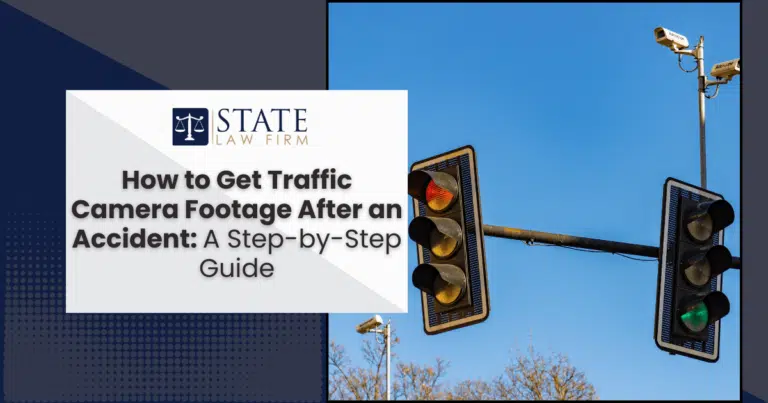In the aftermath of a car accident, securing clear and compelling evidence is crucial for establishing fault and ensuring rightful compensation. One often-overlooked yet invaluable source of such evidence is traffic camera footage. Studies have shown that traffic cameras can reduce fatal red-light running crashes by 21%, underscoring their role in monitoring and enhancing road safety.
At State Law Firm, our team of dedicated Sherman Oaks car accident lawyers understands the pivotal role timely access to this footage can play in strengthening your case. We are committed to guiding you through obtaining traffic camera footage, ensuring that you have the necessary evidence to support your claim. For more information on how we can assist you, please visit our Sherman Oaks car accident lawyer page.
In this guide, we’ll walk you through a step-by-step process to help you efficiently obtain traffic camera footage after an accident, empowering you to take informed action during a challenging time
Understanding the Importance of Traffic Camera Footage
Traffic camera footage serves as a powerful tool in accident investigations, providing unbiased, time-stamped evidence that can help establish fault and clarify the sequence of events leading up to a crash. Unlike eyewitness testimony, which can be subjective or inconsistent, video evidence offers a clear, indisputable account of what happened.
Key Benefits of Traffic Camera Footage in an Accident Claim:
- Clarifies liability – Video footage can show which driver had the right of way, who ran a red light, or whether reckless driving was involved.
- Supports insurance claims – Having concrete evidence can make it easier to secure fair compensation from insurance companies.
- Strengthens personal injury cases – In the event of a dispute, traffic camera footage can serve as strong legal evidence in court.
California has various laws governing the use and accessibility of traffic camera footage. Understanding your rights when requesting this footage is crucial. For more on California’s surveillance camera laws, check out this resource.
Step 1: Identify the Location of the Accident
Before requesting footage, you must determine whether a traffic camera captured the accident. Not all intersections or highways have surveillance cameras, so knowing where to look is key.
How to Identify Nearby Cameras:
- Check intersections – Many cities have red-light cameras at major intersections.
- Look for freeway cameras – The California Department of Transportation (Caltrans) operates traffic monitoring cameras throughout the state. View their camera FAQs here.
- Review private cameras – Businesses, gas stations, and residential properties may have security cameras that captured the accident.
Pro Tip: Take detailed notes about the accident scene, including nearby landmarks and street signs. This information will be useful when requesting footage.
Step 2: Gather Necessary Information for Your Request
To successfully request footage, you need to provide accurate details about the accident. Government agencies and private entities will require specific information to locate and retrieve the relevant footage.
Essential Details to Collect:
- Date and time of the accident – Provide a precise timeframe to ensure your request is processed efficiently.
- Exact location – Mention the intersection, freeway, or nearest landmark.
- Vehicle details – Include license plate numbers, vehicle makes, and models.
- Police report number – If law enforcement was involved, a police report number can help expedite the request.
Pro Tip: If possible, obtain witness statements or additional video evidence from dashcams and nearby security cameras to support your case.
Step 3: Determine Who to Contact for Accessing Footage
Once you have all the necessary details, the next step is identifying the correct agency or entity from which to request footage.
Where to Request Traffic Camera Footage:
- Local law enforcement agencies – Police departments may have footage from city-operated cameras.
- Municipal traffic management centers – Many cities have dedicated departments overseeing traffic surveillance.
- Caltrans – If your accident occurred on a highway, you may need to contact Caltrans for available footage.
- Private businesses – Security cameras from local businesses may have recorded the accident.
For additional information on red-light camera enforcement and retrieval processes, check out this guide from SFMTA.
Pro Tip: Agencies may only retain footage for a short period (typically 7-30 days), so acting quickly is essential.
Step 4: Submit Your Request for Accessing the Footage
Once you’ve identified the appropriate agency, it’s time to submit your request. Each agency may have different protocols for requesting footage, but many follow a similar process.
How to Submit a Request:
- Prepare a formal written request. Include all necessary accident details and your reason for requesting the footage.
- Submit a Public Records Act request – In California, you may need to file a request under the California Public Records Act (CPRA).
- Follow agency-specific procedures – Some agencies may require you to complete specific forms or pay a small processing fee.
Pro Tip: Keep copies of all correspondence and document any communication with the agency to track your request’s progress.
Step 5: Follow Up on Your Request and Know Your Rights
Once your request is submitted, it’s important to follow up and ensure it is being processed on time.
What to Expect After Submission:
- Response times vary – Agencies may take anywhere from a few days to several weeks to respond.
- Your request may be denied – Common reasons for denial include privacy concerns, expired footage retention periods, or lack of proper authorization.
- You have the right to appeal – If your request is denied, you may be able to challenge the decision through an appeal or legal action.
If you’re facing difficulties obtaining footage, working with a skilled personal injury attorney can make all the difference. At State Law Firm, we know how to navigate bureaucratic hurdles and fight for the evidence you need to build a strong case. If you need legal assistance, don’t hesitate to reach out to our team.
Final Thoughts
Traffic camera footage can be a game-changer in proving liability and securing fair compensation after an accident. By following this step-by-step guide, you can increase your chances of obtaining critical evidence. If you need legal guidance or have trouble accessing footage, our experienced team at State Law Firm is here to help.


